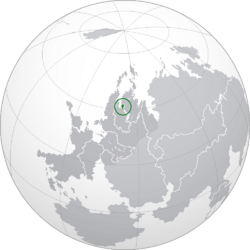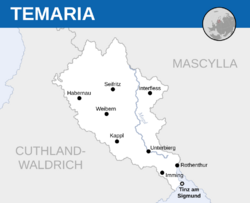Temaria
This article is incomplete because it is pending further input from participants, or it is a work-in-progress by one author. Please comment on this article's talk page to share your input, comments and questions. Note: To contribute to this article, you may need to seek help from the author(s) of this page. |
Republic of Temaria | |
|---|---|
| Motto: "Fräiheet iwwer allem" (Temarian) "Freiheit vor allem" (Hesurian) ("Liberty above all") | |
| Anthem: "Unser liebe Fraue" ("Our Dear Lady") | |
 Temaria (green) shown within the continent of Berea (dark grey). | |
 | |
| Capital and largest city | Tinz am Sigmund |
| Official languages | Temarian, Hesurian |
| Recognised regional languages | Cuthish |
| Ethnic groups (2015) | 90.4% Temarian 9.6% Other |
| Religion | No official statistics |
| Demonym(s) | Temarian |
| Government | Unitary parliamentary republic |
• President | Xaver Meier |
• Minister of State | Annaliese Keller |
| Legislature | Landsrat |
| Independence from Cuthland-Waldrich | |
• Principality of Temaria | 900s |
• Conquered by First Cuthish Empire | January 11, 1444 |
• Annexed by Aldia | March 5, 1621 |
| May 18, 1793 | |
| November 9, 1841 | |
| 1916 | |
| Population | |
• 2020 estimate | 2,681,410 |
• 2017 census | 2,551,993 |
| GDP (PPP) | 2020 estimate |
• Total | |
• Per capita | |
| GDP (nominal) | 2020 estimate |
• Total | |
• Per capita | |
| Gini (2020) | 29.8 low |
| HDI (2020) | 0.944 very high |
| Currency | Temarian karning (TKN, TӃ) |
| Date format | dd/mm/yyyy |
| Driving side | right |
| Calling code | +50 |
| Internet TLD | .tm |
Temaria (Temarian: Tämerland, Hesurian: Tamerland), officially the Republic of Temaria (Temarian: Republiek Tämerland, Hesurian: Republik Tamerland), is a landlocked country in the Telmerian peninsula in north-eastern Berea. It borders Cuthland-Waldrich to the south and west, and Mascylla to the north. To the east, Temaria has a small coastline on Lake Sigismund, where its capital, Tinz am Sigmund, is located. Other urban settlements in the country include Weibern, Seifritz, Rothenthur, Kappl and Unterbierg. The country as a population of 2,681,410 as of 2020, making it the second-smallest country in Telmeria ahead of Lilienburg. The country is comprised of ten cantons and is located in the middle of Gasselian Mountains, where the source of the Mogt river, which also runs through the country, is located.
Temaria was originally inhabited by the Temeres, a Telmeric tribe closely related to their neighbours in Mascylla and Cuthland. The Albarian Kingdom to the north introduced widespread Cambran-era technology to Telmeria shortly after the empire's attempts to expand northwards. Ingmar the Great consolidated the Temeres into the Principality of Temaria in the 800s, becoming the southernmost of the medieval-era Mascyllary kingdoms. The principality lasted around 600 years until it was conquered by the First Cuthish Empire in 1444, the first of multiple conquests that set the Cuthish-Mascyllary borderlands in Temaria. Under Cuthland, the Temarian language and culture was repressed and Cuthish people were encouraged to settle in Temaria to outweigh the local population. Extensive Cuthish and Waldrisian influence on Temaria saw the culture begin to diverge from mainland Mascyllary culture in the 1500s, before it was conquered by the Kingdom of Aldia in the Mögt War. Temaria was part of Aldia during the process of Mascyllary unification in 1793, becoming a part of a unified Mascylla with the Treaty of Langquaid. Cuthland conquered Temaria once again in 1841, before Temaria gained its independence with the Treaty of Lehpold in 1916.
The country's first Minister of State, Emil Ulmer, characterised the nation's development into an extensive free market economy with a developed welfare state. Temarian industry benefitted from the Temarian sale of arms to rebel groups in Cuthland and the Mascyllary government in the late-1910s and 1920s, despite condemnation from the international community. Temaria joined the Assembly of Nations in 1930, and began a process of economic and social integration with Mascylla under Augustin Reichleitner. The Temarian government collapsed during the Melasian Crisis over the ruling coalition being divided on support of Mascylla or neutrality, and led to the ratification of the 1946 Temarian constitution, transitioning Temaria from a presidential system to a parliamentary system, with the President adopting a figurehead role. Since then, Temarian politics have traditionally been dominated by the National Greens, a right-wing green party that has contributed extensively to Temaria's environmental maintenance and quality.
Temaria is renowned for its geographical landscapes, situated on the Mögt river that runs through the Gasselian Mountains, which dominate the country's northern landscapes. The country also has a sizable amount of lakes within its borders, as well as coastline on the larger Lake Sigismund. Temaria's famous natural landscapes are also accompanied by a diverse array of flora and fauna, many of which are native only to Temaria and its immediate surrounding area. Green politics and eco-tourism have been significant in preserving Temaria's natural areas, with over 30% of the country being protected from significant human activity.
Today, Temaria remains one of the world's most developed countries. With one of the world's highest Human Development Indexes at 0.944 and GDPs per capita at $66,112 (PPP), $81,019 (nominal), a low-category Gini coefficient at 29.8, and an extremely developed service sector with a branching quaternary sector, as well as one of the world's most encompassing welfare states, including free-at-use universal healthcare for Temarian citizens. It is a member of the Assembly of Nations and enjoys sizable economic and social integration with its neighbour Mascylla, and, more recently, with Cuthland-Waldrich, with Temaria relying on the former for national defense purposes.
Etymology
History
Prehistory
Principality
Middle ages and Cuthish conquest
Early modern history and Aldian conquest
Mascyllary reunification and Cuthish reconquest
Great War
Modern history
Geography
Climate
Environment
Geology
Biodiversity
Flora
Fauna
Politics
Politics in Tamerland take place through the framework of a multi-party parliamentary democracy whereby the President (Temarian: President, Hesurian: Präsident) is the country's head-of-state and the Minister of State (Temarian: Staatsminister, Hesurian: Staatsminister) is the country's head-of-government. Since 1946, Temaria has used single transferable vote (STV) to elect the members of its unicameral legislature, the Versammlung. Ministers of the Versammlung must belong to a parliamentary party or bloc when they are elected, and, since 2012, whilst they are sitting in parliament. The Minister of State is not directly elected during a general election, but will serve as such by way of being the leader of their respective parties or the leader of any governing coalition. The current president is Xaver Meier and the current Minister of State is Annaliese Keller of the ruling Green–Liberal Conservative coalition.
The Constitution of Tamerland is a codified document that acts as the supreme law of the land. The constitution was first drafted and ratified upon the country's independence in 1916, but was heavily changed and amended during the Thalmann Crisis, eventually resulting in the 1946 constitution, which is the most recent iteration of the document. The 1916 constitution outlined Temaria as a unitary presidential republic, but was changed to a parliamentary republic and the president demoted to a figurehead role in 1946. Since then, the president serves mainly as a ceremonial role who represents the country in official state visits elsewhere as well as a government representative in domestic affairs such as diplomatic missions from other countries in Temaria. The Minister of State leads their respective party or coalition in the Versammlung, although they themselves are not required to be a sitting member of the legislature. Laws and bills are introduced, courted, amended, and accepted or rejected by majority vote of the Versammlung, although amendments, rejections and passings of law can often be passed to national plebiscite through the use of political petitions, one of many implementations of direct democracy in Temaria. A petition must gain the signature of 10% of the electorate (usually around 150,000 signatures) in four months to send any change in law to plebiscite. The frequency of referenda and plebiscites in Temaria contributes to the country recording one of the lowest average national turnouts for referenda in the world.
The Temarian judiciary is split into three tiers, Stadgeriichter (town courts), the lowest tier of court that deals with minor offenses on an extremely local level. Kantongeriichter (cantonal courts), the middle tier of courts that deal with serious offenses on a cantonal level. The cantonal courts are frequently used for any criminal offense deemed as a Tier II offense outlined by Section 1, Article 3b of the Temarian Civil Law Code (referred to as the Zivilrecht), which deals with "any individual criminal offense seeking to cause extent and intentional harm to an individual, property, or other such entity". Tier II crimes are often interpreted as murder, sexual assault (including rape) as well as arson. The final level of the judiciary are the Staatsgeriichter (state courts). State courts deal with "immediate threats to the state, including treason, assassination or intent to cause withstanding damage to the Temarian government or its operations", outlined as Tier III offenses in the Civil Law Code. Temarian courts are impartial, with judges appointed independently of the country's political system, and are supported by an intensive, intricate and thorough appeals system that citizens can use to attempt to overturn their convictions.


